A Wonderful Dilemma….Part 2
I mentioned earlier this week about our beautiful Palo Verde tree that fell victim to the high winds of a monsoon storm. As sad as I was for the loss of my tree, I began to realize that I would now have to choose a replacement. Now I don’t know about you, but I just love it when I get to buy a new tree or plant. My husband is not usually as excited as I am because he is usually the one digging the holes 😉
Faced with the wonderful dilemma of having to choosing what type of tree to plant, I have began to go through the list of candidates – listing their positives and sometimes the negatives. In my last post, we looked at 12 different trees and today I would like to finish the list of prospective tree choices.
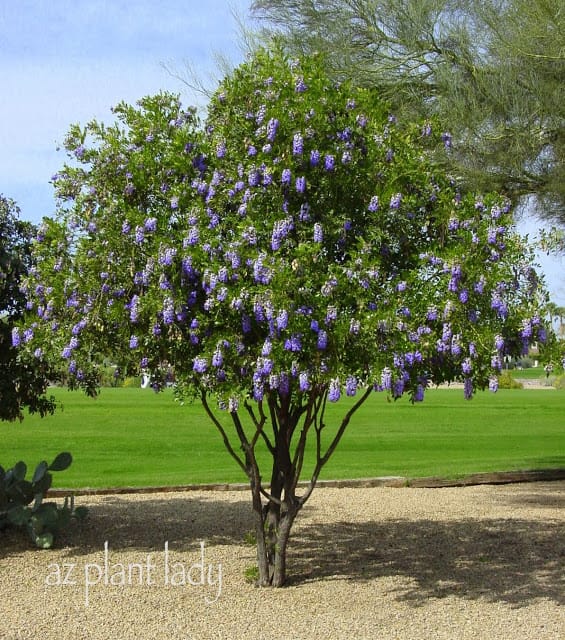
Texas Mountain Laurel (Sophora secundiflora)
I think it is the purple flowers that show up in the springtime that make this one of my favorite small trees. The flowers are not only beautiful, but they perfume the air with the fragrance of grape bubblegum.
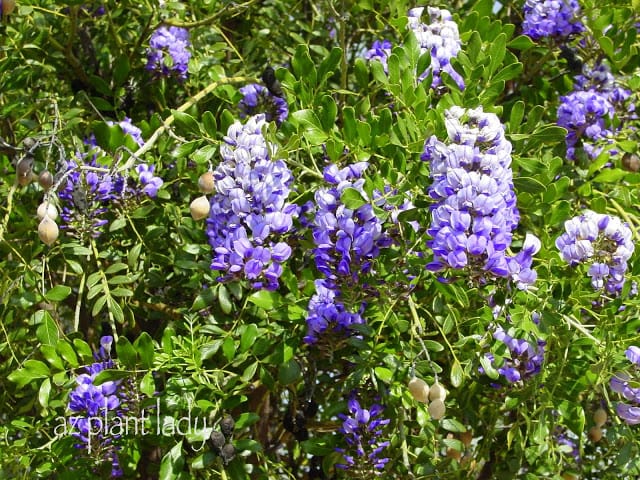
When not blooming, Texas Mountain Laurel makes an extremely attractive evergreen tree or large shrub, depending on how you prune (train) it. At maturity, it can reach heights of 15 – 25 ft. high and up to 15 ft. wide. I like how it grows in full sun as well as light shade. The fact that it is thornless is a bonus.
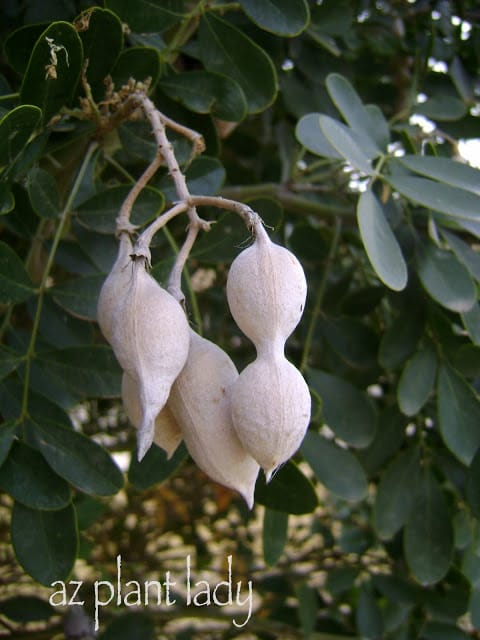
Most people I have spoken to are not generally fans of seedpods and try to stay away from trees that produce them. However, most do not mind the seedpods of the Texas Mountain Laurel, because they add an attractive element to the tree. The seedpods contain bright red seeds that are poisonous, but are extremely hard. As a result, experts say that the seeds would likely pass through the digestive tract, undigested.
*Caterpillars can become a problem during warm weather, but you can just ignore them and/or pick them off. If you see loose webbing on the leaves, that is a sign that it is infected by caterpillars. The damage caused from the caterpillars does not usually hurt the tree. It helps if you detect the eggs before they hatch and remove them. Since caterpillars usually infect the new growth, I just prune off the affected areas.
As much as I love this small tree, I will probably look for something that will grow a little taller.
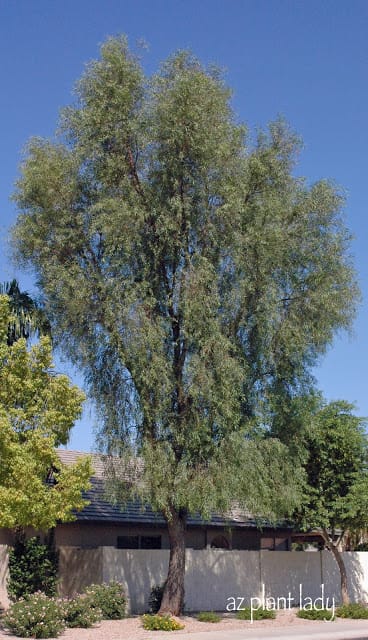
Willow Acacia (Acacia salicina)
Another of my favorite imports from Australia, Willow Acacia offers beauty in narrower spaces. I planted over 100 of these trees in golf courses. Their relative low maintenance, lack of thorns, and graceful willow-like growth habit makes this tree an asset in many areas. I also love that fact that they are evergreen. You can see them growing in common areas, entry and patio gardens as well as golf courses.
Their mature size of approximately 40 ft high and 20 ft. wide make this a great selection to use in a narrow space such as a side yard.
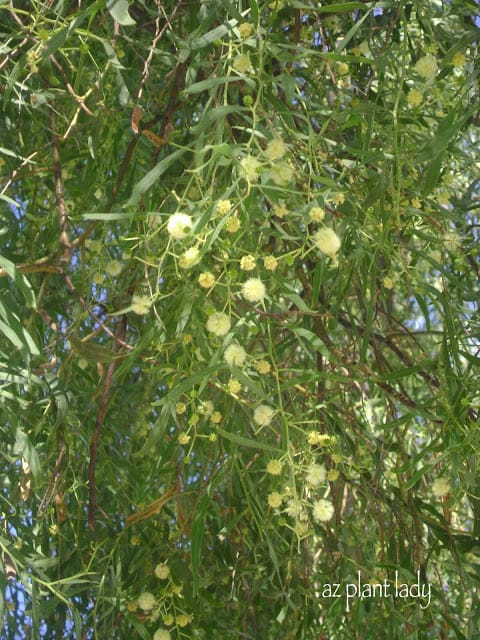
In late summer and fall, cream colored, puffball flowers appear which have a pleasing, light fragrance.
I may have to seriously consider planting a Willow Acacia….
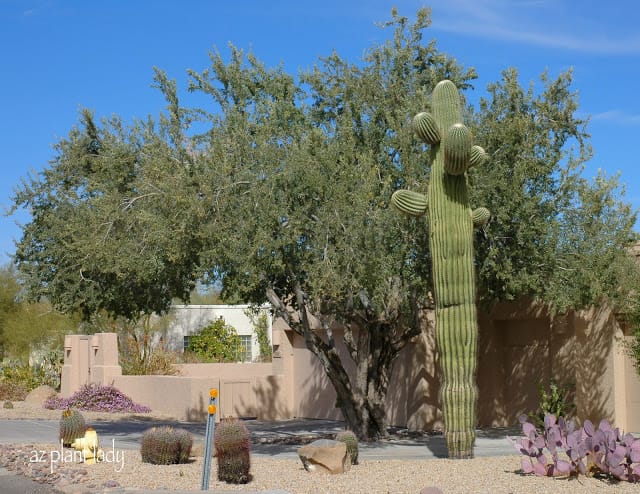
Ironwood (Olneya tesota)
A somewhat iconic desert tree is the Ironwood. Native to the southwestern deserts, this tree is characterized by gray-green foliage, and extremely hard wood. A slow growing tree, it can reach 30 ft. high and 25 ft. wide, although I have seen some specimens that are larger. Almost evergreen, it loses it’s leaves just before flowering in late winter, although severe drought can also cause it to lose it’s leaves.
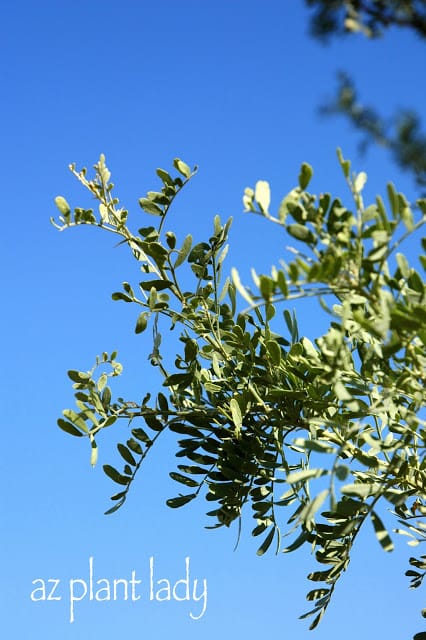
This beautiful tree does best in full sun and should be kept away from close proximity to pedestrian areas as the thorns can be troublesome. In late winter, their flowers begin to appear. The trees appear covered in a lavender mist. The flowers are small but are incredibly breathtaking up close…. but you can easily miss them, so pay attention.
Ironwood trees are often found growing on golf courses in our area. Usually, the golf course was built around certain specimen trees that were already present. Ironwood trees do not fare very well over time when planted in grassy areas. I have seen my share of stately Ironwood trees decline over time on golf courses until they had to be removed.
I do love this tree, but would like to keep away from having thorny trees in my back garden where my children play and would also like a tree that is somewhat faster growing. **I am normally a proponent of purchasing trees in smaller containers such as a 15- gallon tree instead of a 24″ box tree because once in the ground, the 15-gallon tree will rapidly catch up in size to the planted 24″ box tree. BUT when shopping for a tree that is known to be a slow-grower, then I do recommend buying the largest size you can afford.
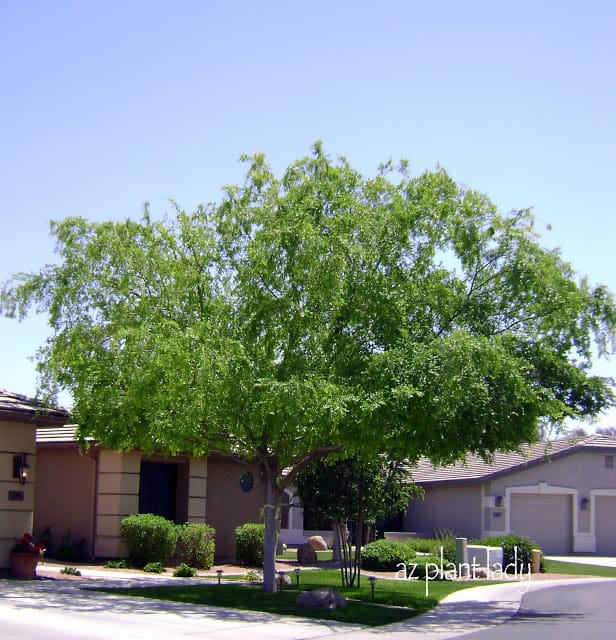
Evergreen Elm (Ulmus parvifolia)
Contrary to the common name, Evergreen Elm, this beautiful shade tree is NOT evergreen. *I would really love to talk to the people who come up with these common names 😉 If you want a large shade tree, then this is a great selection. Bright, light green leaves, smooth bark that chips off in the shape of puzzle pieces, thornless…..there is little not to love. It does drop it’s leaves in winter and they do not change into pretty autumn colors before falling off.
When deciding where to plant, make sure to allow plenty of room for the roots of this 35 ft. x 35 ft. tree. The dense shade it produces is a welcome respite from a hot, summer day. But the shade makes it difficult for summer grass to grow underneath as well as many plants.
Personally, I would like to try to find an evergreen tree for my garden that does not produce dense shade because I do like to plant underneath my trees.
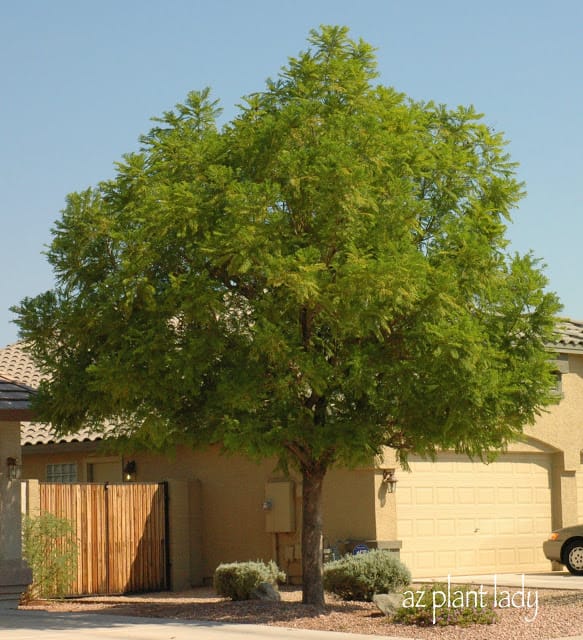
Jacaranda(Jacaranda mimosifilia)
Growing up in Southern California, Jacaranda trees are quite familiar to me. I love their tropical foliage and the flowers are just beautiful. Many transplanted Californians now make their home in Arizona and as a result, like to plant many plants that remind them of home.
Jacaranda trees are actually native to Brazil, but are grown in tropical and semi-tropical regions around the world. In their native, tropical climate, they can exceed heights of 50 ft. x 30 ft. wide. In our semi-tropical, arid climate, they do not grow quite as large as those grown in areas with warmer winters, such as California.
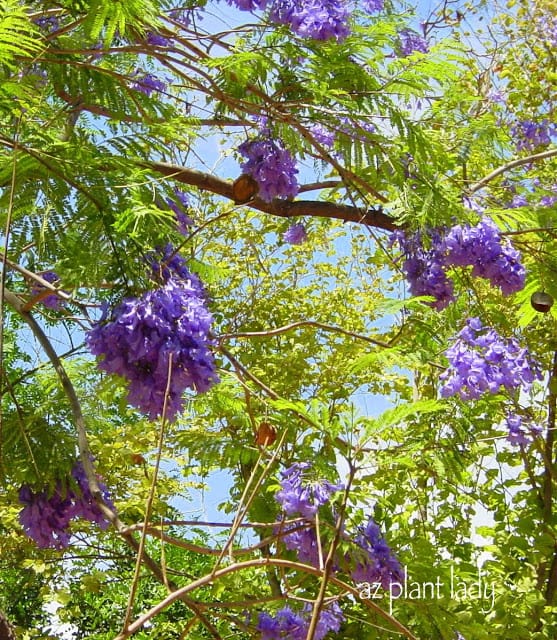
The flowers are just lovely and when they fall, they create a carpet of purple underneath the tree….so don’t rush to rake up the fallen flowers.
In areas with cooler winters, they do lose their leaves. They can also be damaged by hard frosts which sometimes occur in our area, so I would recommend planting in an area that receives some protection from frost.

My parents had a Jacaranda tree in their San Pedro, CA garden and so did my father-in-law in his Scottsdale, AZ garden. As a result, I was able to enjoy their beauty up close. But, I would rather plant a tree that is more tolerant of the occasional hard frosts that my zone 8b garden receives.
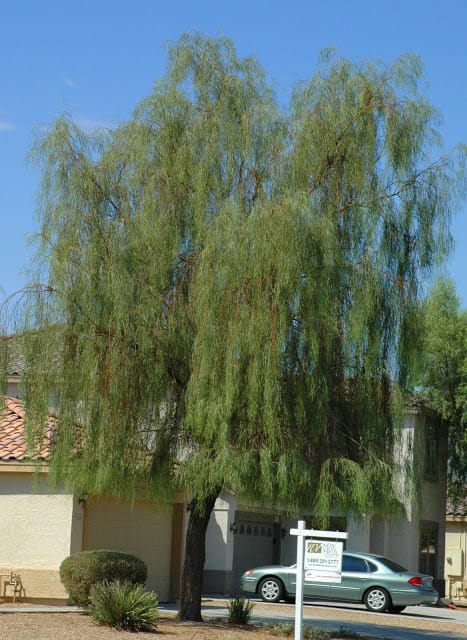
Shoestring Acacia (Acacia stenophylla)
Another import from Australia, Shoestring Acacia makes a wonderful addition to the residential landscape. They are also found growing in parking lots, common areas and golf courses.
This is also a great tree for narrow areas. Evergreen, thornless and long leaves that remind you of shoestrings, hence the common name. At maturity, they can reach heights of 30 ft. high while only reaching 20 ft. wide.
Even if you aren’t a fan of seedpods, these pods look very cool, I think….
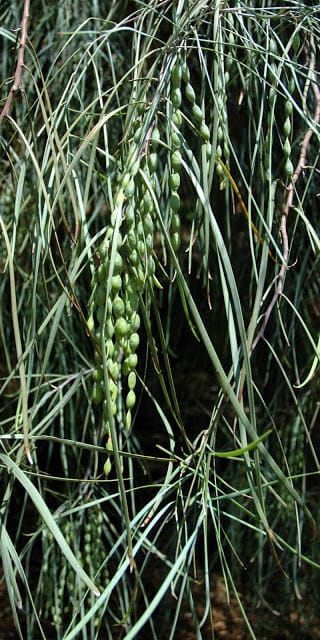
These seedpods make great Christmas decorations for the tree….they look like beads strung together. One Christmas, I had a tree solely covered with seedpods from different trees. My mother makes fantastic wreaths out of seedpods. I will probably do a seedpod post soon.
There really nothing negative about Shoestring Acacias, except that they can look somewhat scrawny when they are young. I remember planting them in groups of three around golf courses when the superintendent (my boss) asked me if they would always look so scrawny. I promised him that in 2 years, he would be thanking me for planting them….and he did 😉 Just be patient and you will be rewarded.
Shoestring Acacia is a tree that I may need to consider my garden.
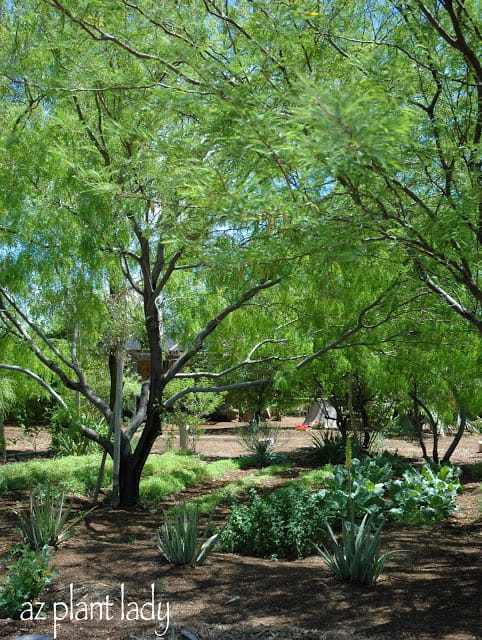
Mesquite (Prosopis species)
Besides Palo Verde trees, Mesquites are probably the second most iconic tree of the desert southwest. You may be surprised to find out that the Mesquite trees found in most landscapes are not the same ones found growing out in the desert, but rather imports from South America.
Mesquite trees are known for growing quickly and providing filtered shade. There are many good reasons to include one in your garden as well as some negatives to be mindful of. The most important consideration for most homeowners is whether the Mesquite they have chosen is a thornless species or not.
First the positives…..beautiful shade tree, moderate to fast growing, thornless varieties available, edible seedpods, flowers attract bees which serve to pollinate other areas of the garden.
Now the negatives…..susceptible to damage from the wind, needs to be staked longer then some other types of trees, thorns (depending on variety), seedpod litter, invasive roots, susceptible to mistletoe infestation, pruning is often required more than once a year.
Here is a list of the most popular Mesquite species and their characteristics:
Argentine Mesquite (Prosopis alba)
20 – 40 ft. high and wide
Thorns
Mostly evergreen
Native to South America
Chilean Mesquite (Prosopis chilensis)
30 ft. high and wide
Some types are thornless
Semi-deciduous (Loses most leaves in winter)
Native to South America
Honey Mesquite (Prosopis glandulosa)
15 – 30 ft. high / 20 – 40 ft. wide
Thorns
Deciduous (loses leaves in winter)
Native to southwestern North America
Velvet Mesquite (Prosopis velutina)
30 ft. high and wide
Thorns
Semi-evergreen
Native to southwestern North America
I love the beauty of Mesquite trees and have grown many both professionally and in my own garden at one time. But for me personally, the maintenance that they require is more than I want to do in my own garden.
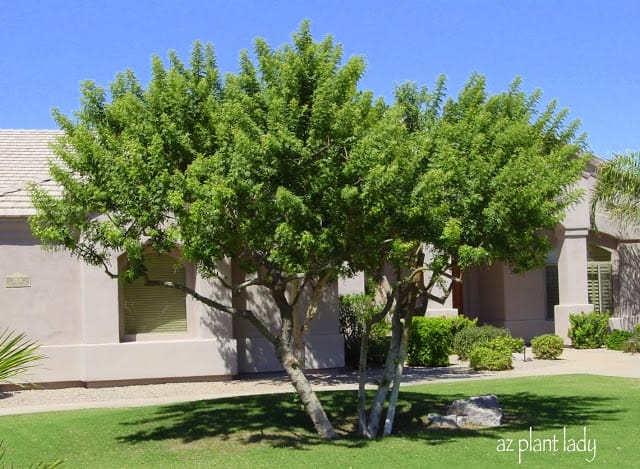
Brazilian Pepper Tree (Schinus teribinthifolius)
This attractive tree has a multitude of uses in the landscape. Brazilian Pepper trees can be found in parks, golf courses, along roadside plantings and residential landscapes. It’s mature size of 15 – 30 ft. high and wide makes it suitable to be used as a patio tree.
In winter, it is evergreen and the female trees produce pretty red clusters of small berries. The fact that it is also thornless makes it a welcome addition to the garden.
Although it is somewhat invasive in humid climates, that is not a problem in arid regions.
I’m not sure about this one for my garden….maybe?
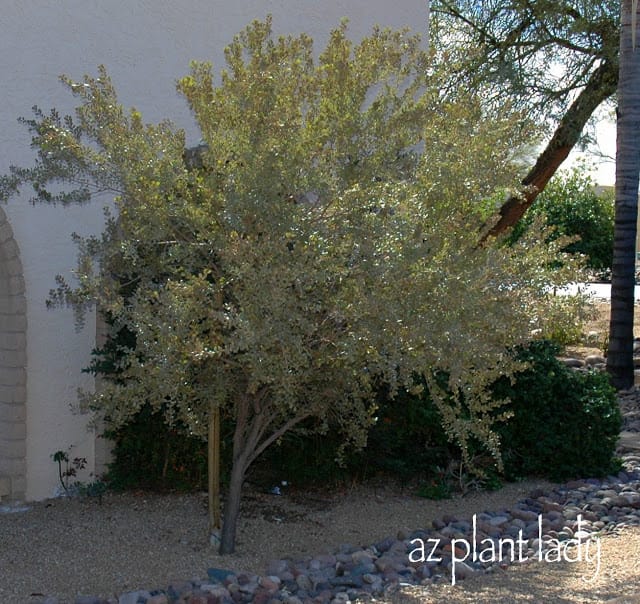
Leatherleaf Acacia (Acacia craspedocarpa)
This small tree can create great contrast in the landscape with it’s gray-green leaves. I find it looks most attractive when planted in groups of 3 or 5, although it would make a great patio tree if planted alone.
Native to Australia, it’s relative small size of 10 – 15 ft. high and wide make it perfect for small areas.
Evergreen, thornless, extremely low-maintenance and interestingly shaped leaves make this tree an asset in the landscape. The leaves are thick and somewhat leathery in texture, hence it’s common name.
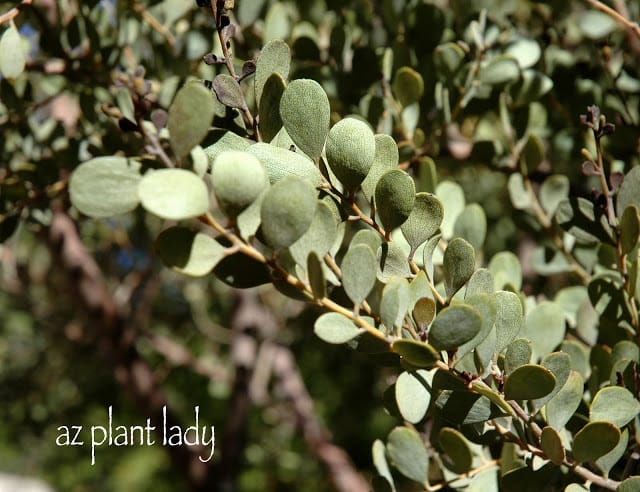
I have not personally grown this tree, but would not hesitate too. But in this case, I am looking for a larger tree.
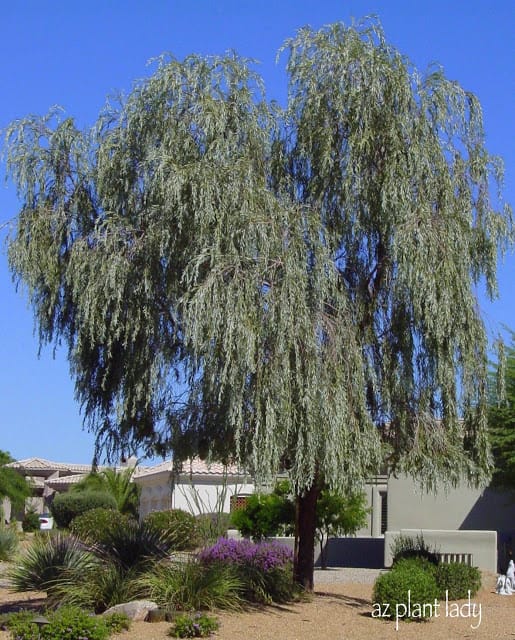
Weeping Acacia (Acacia pendula)
I love the botanical name for this Australian native as it so aptly describes the pendulous branches. I really have a thing for trees that have a weeping type of growth. I’m not sure why.
This tree grows up to 40 ft. high and 25 ft. wide. The light gray-green color also contrasts nicely with darker green foliage in the landscape. The rate of growth is rather slow, so I think I will not add this one to my list.
Well, I wish that I could say that I know exactly what type of tree I am going to plant, but I am honestly not sure. I wrote these posts to help myself as well as those who may be considering some of these trees as well in order to help them with their choice.
I will probably hold off until October or November to make my final decision as they are the best months for planting in our area.
************************
Right now, my vegetable garden is calling to me to come out and plant some seeds.
I hope you are all having a great weekend!

 Noelle Johnson, aka, 'AZ Plant Lady' is a author, horticulturist, and landscape consultant who helps people learn how to create, grow, and maintain beautiful desert gardens that thrive in a hot, dry climate. She does this through her consulting services, her online class Desert Gardening 101, and her monthly membership club, Through the Garden Gate. As she likes to tell desert-dwellers, "Gardening in the desert isn't hard, but it is different."
Noelle Johnson, aka, 'AZ Plant Lady' is a author, horticulturist, and landscape consultant who helps people learn how to create, grow, and maintain beautiful desert gardens that thrive in a hot, dry climate. She does this through her consulting services, her online class Desert Gardening 101, and her monthly membership club, Through the Garden Gate. As she likes to tell desert-dwellers, "Gardening in the desert isn't hard, but it is different."
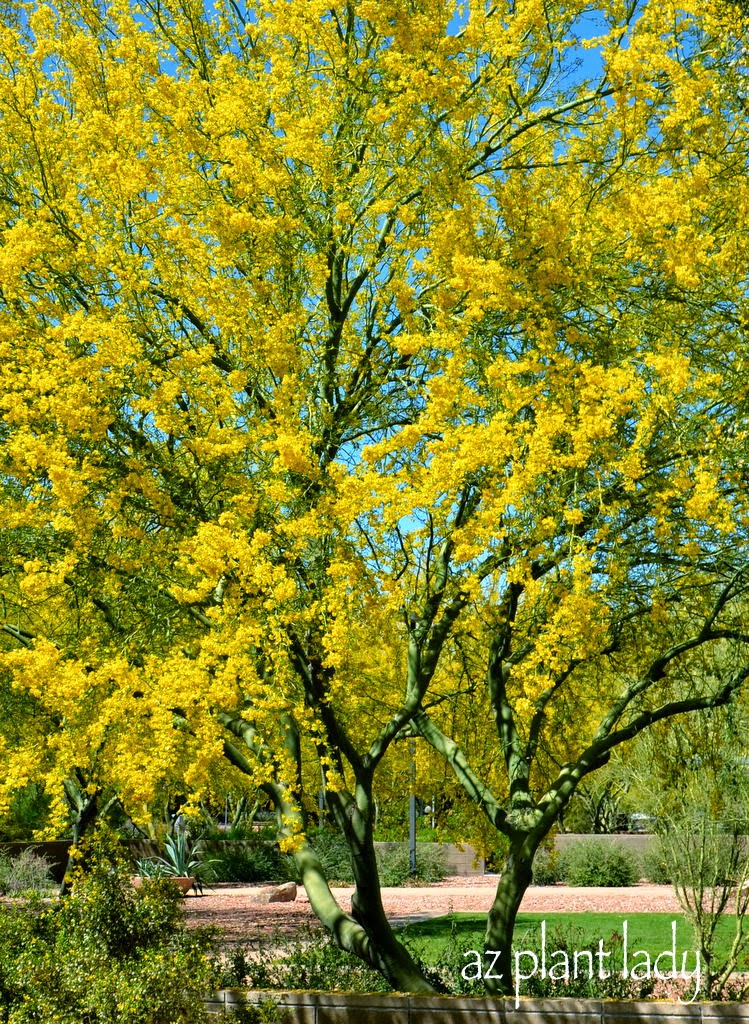
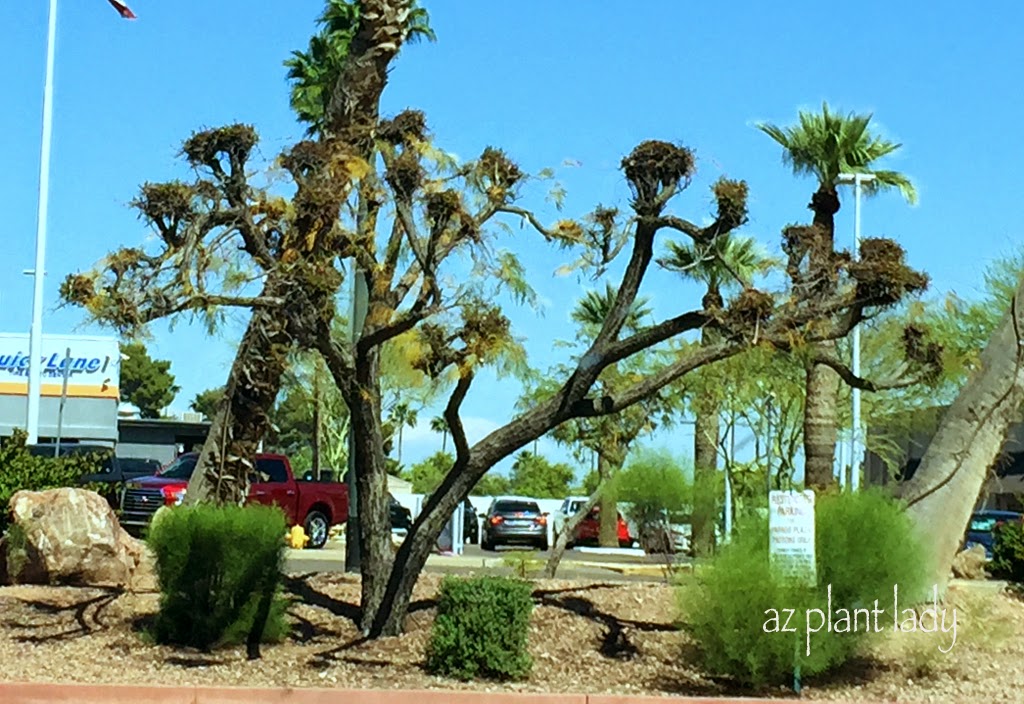
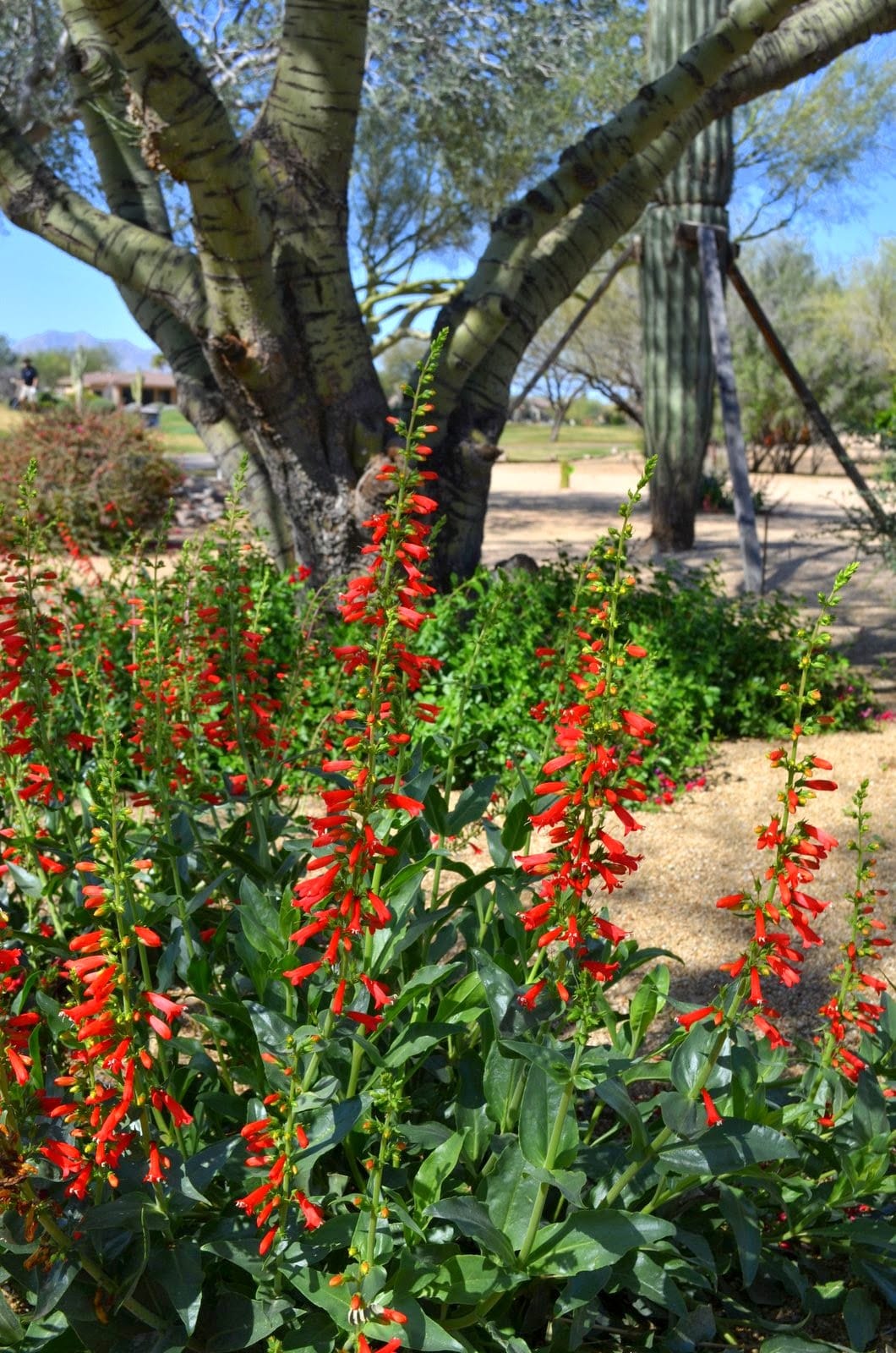
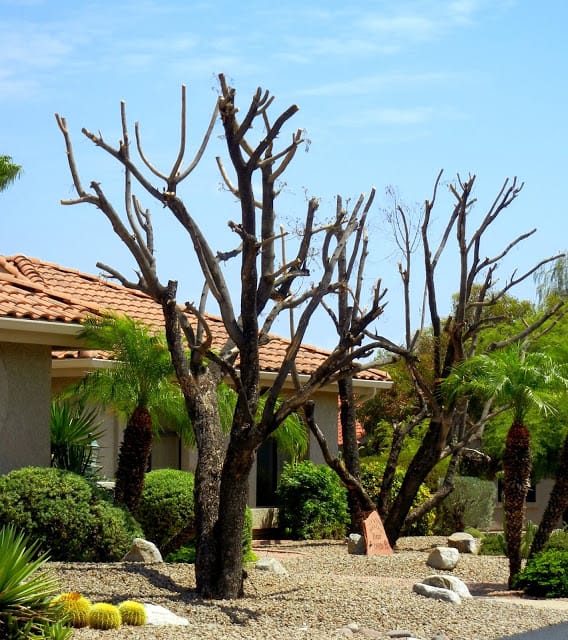
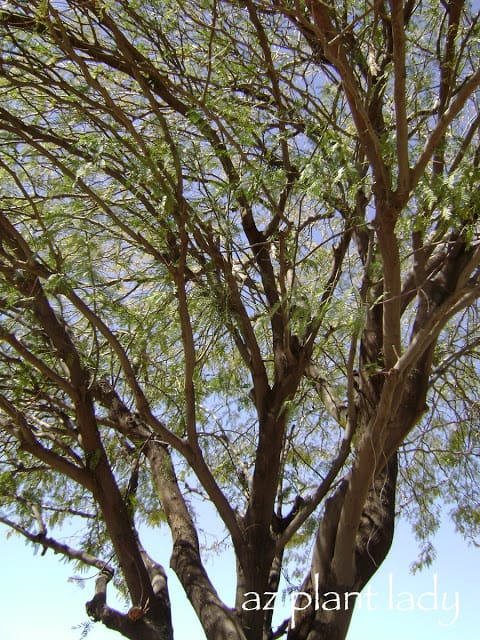
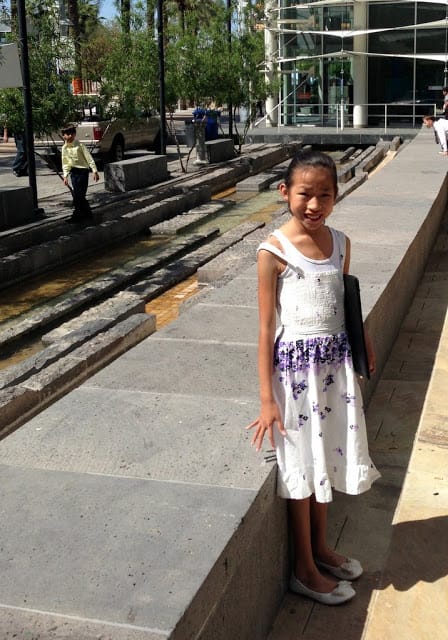





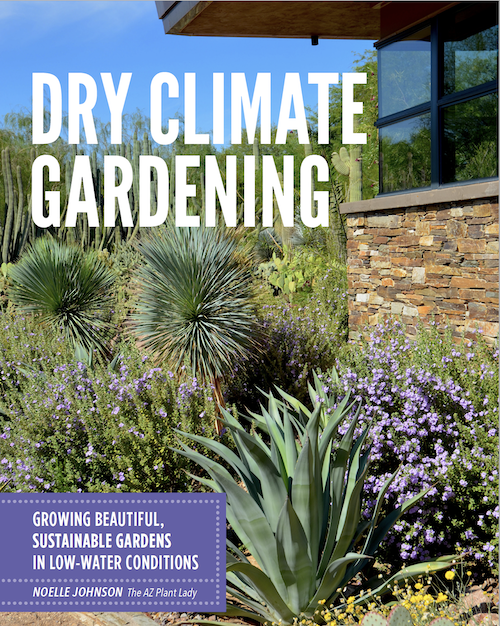
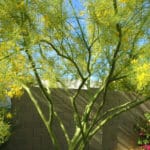
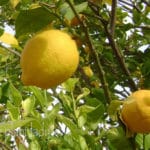
Hi Noelle,
So many possibilities…I love the Mountain Laurel and have one. They are very very very slow growing but absolutely worth the wait…if you are willing. My favorite on your list is the Jacaranda…it's fast growing and has the most beautiful flowers in springs….you really could start small on this guy because he will shoot up within 2 to 3 years…blooms won't come for a year or so….but wow….I think you are up in the Phoenix area so it definitely would do well there. I am in a microclimate in Tucson so it is also doing very well….I'm bias…those purple blooms and ferny leaves are gorgeous…in winter they will shed if it's cold….but wow what a tree:) So I planted the mountain laurel in the background to eventually catch up with the rest of the gang…Both LOVE sun:) I envy you…what fun!!!
Noelle, it's so much fun getting to choose new trees for a landscape. I've been told that at least in parts of California, that the Brazilian Pepper trees are escaping cultivation and become a nuisance in some wildlands. Is that a concern where you are? In regards to the Argentine mesquites, they were so prominent in the dry arid landscapes of Patagonia when I was there. From a distance they're beautiful, but up close, the thorns were brutal! Although the monk parakeets down there would build their nests from the wickedly thorny branches (one way to defend your nest I suppose). I think you're going to have a difficult choice ahead. I'll be curious to see which one you select.
More gorgeous trees!! My faves are the Laurel & Jacaranda, the remind me of lilacs. 🙂 I prefer the Jacaranda a little, since it doesn't produce the large seed pods, but having struggled with borderline hardly plants it is probably wise to steer clear. It's bad enough when a perennial or small shrub doesn't do well, but a tree is so much worse. So I would gravitate towards the Laurel. Good Luck!!
Hi Noelle, The Jacaranda tree is absolutely beautiful. I feel as if I am choosing the tree. Can I have this one? 🙂
Dear Noelle, I am now totally confused as to which tree I should choose and I am only thankful that I am not expected to make the final decision. However, the postings have been wonderful for the way in which you have explored the qualities, good and bad, of so many beautiful trees. I shall be most intrigued to know which you finally select but clearly will have to be patient and wait until October, or even later. I imagine that you will plant bare rooted.
Wow, I'll definite remember this post when I have space to put a tree!
I love trees and hearing about those that grow in your area. I don't think I could decide. Can't you plant more than one? Ha.
So many lovely choices. I didn't know that your region had so many different kinds of trees. I always learn something here. Balisha
I really enjoy how informative your posts are, Noelle. Looking forward to hearing your decision.
What a fun but difficult choice! I'll second the whole slow-growing thing on the mountain laurels. On the upside, the seedpods really aren't an issue and the spring growth is better after years when the caterpillars visit. And I grew up running around barefoot in backyards with ironwood trees; definitely not child-friendly. Jacarandas are beautiful; every time I visit LA, those purple blooms make me wish for a desert climate. And the acacias are great, too. Good luck choosing!
Noelle,
Thanks for the invaluable information. I'm looking for a small tree for new landscaping to replace boring/water sucking lawn in the front of our San Clemente house. Your blog has helped me narrow the choice to Sophora secundiflora and Chilopsis linearis.
Will keep looking to see what you settled on.
Best, Laura
Very nice blog. I'm in So CA and need a new front lawn tree and your pics with pro/con descriptions were just the ticket for those trees that would do very well in my location. Seeing the grown trees in pics is especially helpful! Thanks again!
Can't thank you enough for this amazing write up on Arizona trees! Really helped my decision on a couple trees for my backyard. Thanks so much, please keep up the great work.
Can't thank you enough for this awesome write up on Arizona trees! Really helped me decide on a couple trees for my backyard. Thanks so much, keep up the great work.
Wow! You just solved my mystery as to what the tree with purple "flowers" is – a Texas Mountain Laurel. I was driving down the road, and I kept seeing these beautiful small trees and really wished I knew what their name was. Now I know, thanks to your photo. Thank you much.
Ugh you are so right about the maintenance with mesquite trees! I have two 30 feet tall ones in my backyard. The pruning I don't mind (because I make my husband do it..haha!) It is the roots and the ground. I have struggled to find what ground covering makes the most sense with all leaf droppings.
Hello. I recently moved here from Ohio and have been trying to learn about the various plant life in Arizona. Your post was the most helpful one that I found. My absolute favorite discovery is the Willow Acacia, and am looking forward to adding one to my yard soon. Thank you!
Hi Shawn. I love willow acacia too. They have so many nice characteristics – evergreen, fairly clean, and fast growing 🙂
Hello,
I recently put shale rock into my front yard and out sprung a seedling which is now 5 feet tall for
what a nursery employee called a pepper acacia tree. It has a thin green leaf, with a red hue to the leaf stem.
The bark appears to be brown, do you have any information on this tree as far as origin, and maintenance,
how tall it will grow, etc… I can send a photo if necessary
Hello,
I recently put shale rock into my front yard and out sprung a seedling which is now 5 feet tall for
what a nursery employee called a pepper acacia tree. It has a thin green leaf, with a red hue to the leaf stem.
The bark appears to be brown, do you have any information on this tree as far as origin, and maintenance,
how tall it will grow, etc… I can send a photo if necessary
Hi Kelly,
Please feel free to send me a photo at arizonaplantlady@gmail.com and I’ll do my best to help identify it.
Hey great post! I hope it’s ok that I shared this on my Facebook, if not, no worries just let me know and I’ll delete it.
Either way keep up the good work.
Absolutely! Thank you for sharing. 🙂
Well which one did you settle on and was it a good choice 😉
Kirk
Hi Kirk,
I ended up planting a desert willow – I’m a sucker for its pretty flowers and distinctive fragrance it adds to the landscape.
BTW, I went to your talk last year at the SHADE conference – I’m a big fan of your designs.
Just stumbled upon your article. I am looking for a tree to replace a Brazilian Pepper Tree. I literally hate the tree. It looks like it has been in a fire every summer (it loses all its leaves every summer and is very very messy. I really enjoyed your article that talked about trees specifically for Arizona. I am considering the Chinese Elm. Thanks and keep up the good articles
Hello Theola,
I am so glad that I could help. Chinese elm is a lovely shade tree!
AZ Plant Lady, have you considered an orchid tree for your garden? I first saw them in Palm Desert, CA, then planted one in my Glendora, CA, back yard. It gave lots of flowers and shade during the 1960’s.
I wonder how one would do here in north Scottsdale at our 2085 foot altitude? Now that I think of it, our freezes might be a problem.
Today I am looking for more information on a palo verde tree we planted that does not produce pods but sheds long string leaves. When they fall on the ground and dry, we rake them up and feed to our horses. The tree is quite large now and very susceptible to mistletoe. Our horses like these stringing leaves and the mesquite beans we harvest for them. They do not care for palo verde beans so those end up in the dumpster.
Virginia
Hi Virginia,
I have seen orchid trees grown throughout the Phoenix area, but at your elevation, it may be a problem – especially when we experience a cold winter. Do you think the palo verde tree you are talking about may be a Mexican palo verde (Parkinsonia aculeata)?
I like all your chices ..Gad bkess you
Dear Plant lady,
Thanks for your website and knowledge. I would just like to weigh in on the Shoestring Acacia. My neighbor has a shoestring Acacia and it is a nightmare. It makes a mess all year long. If it is not dropping those annoying yellow fuzzy things, it drops the pods and in the summer it drops dead leaves and long twigs constantly. Most of the work I do on my front yard is raking or blowing the mess into piles, and all this before I can even think about mowing. It is a huge tree, probably close to 80 feet or more. My neighbor hates the tree too but can’t afford the cost of more that 3K to take it down. You may want to pass this along to your readers so they don’t go route.
Mark
Glendale
Hi Mark,
Thank you for sharing your experience. Although shoestring acacia trees are listed on a pool approved list, your experience shows that trees should be carefully selected and kept away from pools. The extra large size of your neighbor’s tree is definitely a factor in the mess that it causes.
I am trying to landscape a 9 acre commercial property in Phoenix. I need hearty, low maintenance, pretty trees and plants. I cannot afford a landscape architect but just a few pointers. Do you ever take calls or donations in exchange for plant/irrigation advice for a small business owner? thanks for your time…..mj
Hello Mary Jo,
I do offer consultation services, and I charge less than a landscape architect. You can find out more about the services I offer under the Landscape Consulting Services tab. I also invite you to explore my website, which has 9+ years of content in regards to trees and plants that do well in the desert.
Best,
Noelle
Hello I am on a quest to find out my nemesis tree
. It grows like a weed, with no care what so ever it will take over a yard and your neighbors Actually it probably came from a near neighbor. It looks almost exactly like a Jacaranda but the flowers are round and yellow. It produces copious amounts of brown seed pods with black tick like seeds. In a wind storm the pods blow everywhere. Can you help, what is the name of this world’s largest tree? Thx
Hello Duane,
I can’t be sure from your description, but a Tipuana tipu comes to mind. They are large, tropical and produce yellow flowers.
Please do not remove caterpillars without identifying them. In the Spring you are likely killing migrating butterflies.
Great point, Rene. It is a good idea to search online for what caterpillars from butterflies look like before removing them.